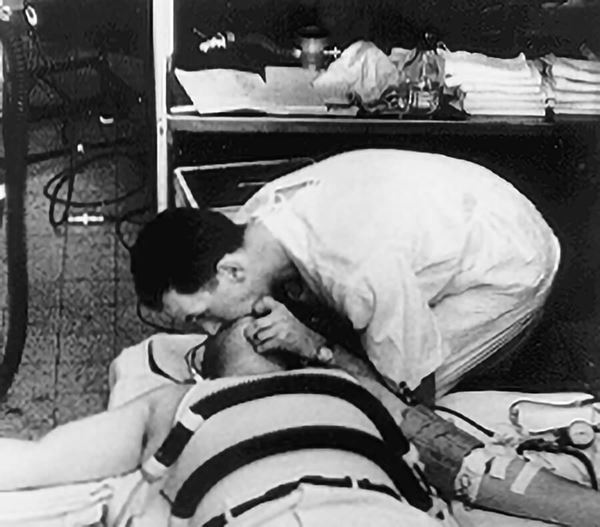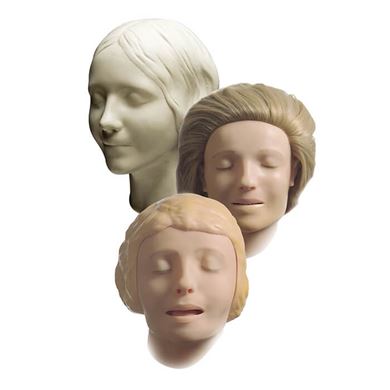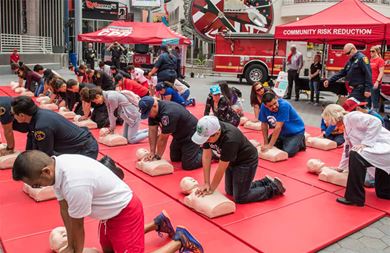History of CPR
Resuscitation:


The Bellows Method
1530-1800s
The Bellows Method1 first used by Swiss physician Paracelsus.
1732
In Alloa, Scotland, local surgeon William Tossach uses mouth-to-mouth breaths to revive a suffocated coal-pit miner. Dr. Tossach documents the success 12 years later, in what may be the first clinical description of mouth-to-mouth resuscitation in medical literature.
1740
The Academie des Sciences in Paris officially recommends mouth-to-mouth resuscitation for reviving victims of drowning.2
1774
London physicians William Hawes and Thomas Cogan found the Society for the Recovery of Persons Apparently Drowned (later to become The Royal Humane Society) to assist victims of sudden and unexpected death.
1775
Experimenting with animals, Danish veterinarian Peter Abildgaard discovers that after rendering a chicken lifeless by shocking it, countershocks to the chest could restore a heartbeat.3
1782
The Royal Humane Society expresses its preference for using bellows rather than mouth-to-mouth ventilation to artificially inflate the lungs.4
The Hall and Silvester methods become the most commonly used forms of artificial respiration until the early 20th century.5

The Hall Method
1856
London physician Marshall Hall introduces his simple resuscitation technique: alternately repositioning the patient from face up to side. He updates the approach by adding pressure on the thorax.6
1858
Henry Silvester, another London physician, creates the chest-pressure arm-lift method: raise the patient’s arms up to expand the chest, then cross the arms over the chest to apply expiratory pressure.7

The Silvester Method
1874
German physiologist Moritz Schiff’s research on animals in Florence, Italy8 reveals that massaging the heart during surgery can restore circulation.
1878
In Germany, Rudolph Boehm shows that external compressions of the heart provide adequate circulation in cats.9
1891
After using external compressions to restart the hearts of 2 young human patients, German surgeon Dr. Friedrich Maass becomes the first to advocate chest compressions, rather than ventilation alone, to help with circulation.10 But the technique doesn’t take hold, and for the next half century, open-heart massage is the standard.
1903
In Cleveland, Ohio, Dr. George Crile’s research confirms that external chest compressions restore circulation in dogs.11
1904
Dr. Crile reports successful closed-chest cardiac massage in 1 human case.12 But once again, the noninvasive technique doesn’t gain traction, and patients continue to receive open-heart massage.

1924
Six cardiologists meet in Chicago and form the American Heart Association (AHA) as a professional society for physicians. Nearly a century later, the AHA will be the world leader in CPR and emergency cardiovascular care (ECC) training and education.
Early meeting of the AHA
1933
Researchers at Johns Hopkins University, led by electrical engineer William Kouwenhoven, PhD, accidentally rediscover external compressions when they find that pressure on a dog’s sternum provides adequate circulation to the brain to keep the animal alive until defibrillation can restart its heart. Their results are confirmed in more than 100 dogs.13
A canine patient in Kouwenhoven’s lab, revived by the team’s experimental combo: external chest compressions and defibrillation.
1947
In Cleveland, Ohio, cardiothoracic surgeon Dr. Claude Beck performs the first successful use of an electric defibrillator on an exposed human heart.14

Original AHA logo
1950
The AHA begins publishing Circulation, a scientific journal that informs doctors, researchers, and others about cardiovascular breakthroughs.
1954
American physician and respiratory researcher Dr. James Elam becomes the first person to prove that expired air is sufficient to maintain adequate oxygenation.15
1956
Dr. Elam and Dr. Peter Safar prove that mouth-to-mouth resuscitation is an effective lifesaving method. Drs. Elam, Safar, and Archer Gordon play leading roles in promoting rescue breathing to professional healthcare providers and the public alike.16
For the first time in human medicine, an external defibrillator successfully restores a steady rhythm to a quivering heart. Harvard cardiologist Dr. Paul Zoll leads the study with funding from the AHA.
1957
The United States military adopts the mouth-to-mouth resuscitation method to revive unresponsive victims.

Dr. Safar performs mouth-to-mouth resuscitation in Baltimore, 1957.

A Hopkins Closed Chest Defibrillator
1957: Johns Hopkins team unveils first portable external defibrillator
After several years of research on closed-chest defibrillation, Dr. Kouwenhoven’s team at John’s Hopkins, which includes James Jude, MD, and Guy Knickerbocker, PhD, unveils its prototype of the first portable external defibrillator (on a wheeled cart): the 200-lb Hopkins Closed Chest Defibrillator.17

(l to r) Doctors Jude, Kouwenhoven, and Knickerbocker
1960
Resuscitation pioneers Drs. Kouwenhoven, Safar, and Jude combine mouth-to-mouth breathing with chest compressions to create cardiopulmonary resuscitation, the lifesaving actions we now call CPR.
The AHA starts a program to acquaint physicians with closed-chest cardiac resuscitation, which becomes the forerunner of CPR training for the general public.

1960: Resusci Anne is “born.”
The life-size training manikin (a collaborative effort by Drs. Safar, Elam, and Gordon and Norwegian toymaker Åsmund Lærdal) goes on to teach CPR skills to more than 400 million people—and counting—worldwide.18
Resusci Anne through the ages: 1960-2018
1963
Cardiologist Dr. Leonard Scherlis establishes the AHA’s CPR Committee. That same year, the AHA formally endorses CPR.
1966
The National Research Council of the National Academy of Sciences convenes an ad hoc conference on cardiopulmonary resuscitation. The conference is the direct result of requests from the American National Red Cross and other agencies to establish standardized training and performance standards for CPR.

Dr. Leonard Cobb
1972
In Seattle, University of Washington cardiologist Dr. Leonard Cobb launches Medic II, the world’s first mass citizen training in CPR.19 During its first 2 years, the program helps train more than 100,000 people.
1973
Second National Conference on CPR and ECC
1975
The AHA publishes the first Advanced Cardiovascular Life Support (ACLS) Textbook.
1981
A program to provide telephone instructions for performing CPR begins in King County, Washington. The program trains emergency dispatchers to give callers CPR instructions while EMT personnel are in route to the scene. Fast forward to the 21st century: Dispatcher-assisted telephone CPR is standard in dispatch centers across the United States.
1983
The AHA convenes a national conference on pediatric resuscitation to develop CPR and ECC guidelines for pediatric and neonatal patients.

1985
Fourth National Conference on CPR and ECC
1988
In co-sponsorship with The American Academy of Pediatrics, the AHA introduces the first pediatric courses: pediatric BLS, pediatric advanced life support (PALS), and neonatal resuscitation.

1990s
Public access defibrillation programs provide training and resources, including AEDs, to the public so that they can help resuscitate victims of cardiac arrest.1990
Fifth National Conference on CPR and ECC
1992
Founding of the International Committee on Resuscitation (ILCOR)
1999
The first task force on first aid is appointed. This year also sees the first International Conference on Guidelines for CPR and ECC.
2004
The AHA and ILCOR release a statement about AED use in children, stating that for children ages 1 year to 8 years who have no signs of circulation, it is appropriate to use an AED.
2005
The AHA develops the Family & Friends® CPR Anytime® kit, an innovative product that enables anyone to learn the core skills of CPR in just 20 minutes. The kit provides everything needed to learn basic CPR, AED skills, and choking relief anywhere, from a family room at home to a setting for instructing large groups.
The 2005 International Consensus on CPR and ECC Science With Treatment Recommendations (CoSTR) Conference leads to the AHA publishing the 2005 AHA Guidelines for CPR and ECC. The Guidelines recommend a new compression-to-ventilation ratio of 30:2 as well as changes to AED usage.
2008 – Simpler CPR for bystanders
The AHA releases new recommendations that bystanders who are untrained, unwilling or unable can use Hands‐Only CPR to help an adult or teen who collapses suddenly,20 delaying rescue breaths until help arrives. The change reflects findings from multiple studies from Dr. Gordon Ewy and colleagues showing that uninterrupted, high-quality chest compressions without rescue breaths can be lifesaving in the first minutes of a sudden cardiac arrest.
2010
After the 2010 International CoSTR Conference, the AHA publishes the 2010 AHA Guidelines for CPR and ECC. 2010 also marks the 50th anniversary of CPR.

2012: Hands-Only CPR Hits the Road to Save Lives
The AHA's Hands-Only Mobile Tour hits the road to teach Hands-Only CPR across the country.
AHA's Hands-Only CPR mobile tour visits southern Maine.
2013
The AHA installs an interactive CPR kiosk at Dallas-Ft. Worth airport. It features a practice manikin, video, and touch screen that give performance feedback as passengers between flights learn to perform hands-only CPR. Within 5 years, there will be more than 30 CPR kiosks in cities across the country.
2015
The Institute of Medicine releases its report Strategies to Improve Cardiac Arrest Survival: A Time to Act (2015). After the 2015 International CoSTR Conference, the AHA publishes the 2015 AHA Guidelines Update for CPR and ECC.
2017
The AHA begins its continuous evidence evaluation process for the Guidelines for CPR and ECC and, later that year, releases the 2017 Focused Update.
2018
In June, the AHA publishes “Resuscitation Education Science: Educational Strategies to Improve Outcomes from Cardiac Arrest” in the journal Circulation. This statement, which is applicable to all resuscitation training programs (not exclusive to AHA), examines best practices in education and applies them to resuscitation. By implementing the statement’s guidance, training programs and resuscitation instructors will help raise the standard of care and increase survival from cardiac arrest.
Footnotes
1 Image 1530-1800s, Europe, The Bellows Method, first used by Swiss physician Paracelsus. Reprinted by permission from Chicago’s Museum of Science and Industry.
2 Baker AB. Artificial Respiration, The History of An Idea. Medical History. 1971;15(4):336-351. https://www.ncbi.nlm.nih.gov/pmc/articles/PMC1034194/pdf/medhist00129-0028.pdf
3 Cakulev I, Efimov IR, Waldo AL. Cardioversion: Past, Present, and Future. Circulation. 2009; 120:1623-1632. https://www.ncbi.nlm.nih.gov/pmc/articles/PMC2782563/ ; Driscol TE, Ratnoff OD, Nygaard OF. The remarkable Dr. Abildgaard and countershock. The bicentennial of his electrical experiments on animals. Ann Intern Med. 1975;83(6):878-82 https://www.ncbi.nlm.nih.gov/pubmed/1106286
4 Trubuhovich RV. History of mouth-to-mouth rescue breathing. Part 2: the 18th century. Crit Care Resusc. 2006;8(2):157-71. https://www.ncbi.nlm.nih.gov/pubmed/16749887
5 Baskett TF. The Holger Nielsen method of artificial respiration. Resuscitation. 2007;74:403-405. https://www.resuscitationjournal.com/article/S0300-9572(07)00168-2/abstract
6 Baskett TF. Silvester’s technique of artificial respiration. Resuscitation.2007;74:8-10. https://www.resuscitationjournal.com/article/S0300-9572(07)00019-6/abstract
Photo courtesy of Laerdal Medical Corporation. 1856-Marshall Hall Method. Chest elevated, a victim is pulled up on his side momentarily, then rolled back. Pressure on back expelled air.
7 Baskett TF. Silvester’s technique of artificial respiration. Resuscitation. 2007;74:8-10. https://www.resuscitationjournal.com/article/S0300-9572(07)00019-6/abstract
Photo courtesy of Laerdal Medical Corporation. 1861-Silvester Method Victim on back, arms over head. Arms moved forward, folded on chest and pressed. Tongue held, keeping air passage open.
8 Vallejo-Manzur F, Varon J, Fromm Jr R, Baskett P. Moritz Schiff and the history of open-chest cardiac massage. Resuscitation. 2002;53:3-5. https://www.resuscitationjournal.com/article/S0300-9572(02)00028-X/abstract
9 Hurt R. Modern cardiopulmonary resuscitation—not so new after all. JR Soc Med. 2005;98(7):327-331. https://www.ncbi.nlm.nih.gov/pmc/articles/PMC1168923/
10 Taw Jr. R. Dr. Friedrich Maass: 100th Anniversary of “New” CPR. Clin Cardiol. 1991;14:1000-1002. https://acilci.net/wp-content/uploads/2013/08/Dr.-Friedrich-Maass-100th-Anniversary-of-New-CPR.pdf
11 Crile G. Blood Pressure in Surgery: an experimental and clinical research. Cartwright prize essay for 1903. https://archive.org/stream/b21510842/b21510842_djvu.txt
12 Hurt R. Modern cardiopulmonary resuscitation—not so new after all. J R Soc Med. 2005;98(7):327-331. https://www.ncbi.nlm.nih.gov/pmc/articles/PMC1168923/
13-14 Beaudouin D. W.B. Kouwenhoven: Reviving the Body Electric. Johns Hopkins Engineering. 2002(Fall):27-32. https://engineering.jhu.edu/magazine/2002/09/w-b-kouwenhoven-reviving-body-electric/#.YRQjGMpKiUl
15 Sands RP, Bacon DR. An Inventive Mind: The Career of James O. Elam, MD (1918-1995). Anesthesiology. 1998;88:1107-1112. http://anesthesiology.pubs.asahq.org/Article.aspx?articleid=1947621
Image Dr. Safar performs mouth-to-mouth resuscitation in Baltimore, 1957. Reprinted by permission from the Safar Center for Resuscitation Research.
16 Sands RP, Bacon DR. An Inventive Mind: The Career of James O. Elam, MD (1918-1995). Anesthesiology. 1998; 88:1107-1112. http://anesthesiology.pubs.asahq.org/Article.aspx?articleid=1947621
17 Beaudouin D. W.B. Kouwenhoven: Reviving the Body Electric. Johns Hopkins Engineering. 2002(Fall):27-32. https://engineering.jhu.edu/magazine/2002/09/w-b-kouwenhoven-reviving-body-electric/#.YRQjGMpKiUl
Image A Hopkins Closed Chest Defibrillator. Photo courtesy of Johns Hopkins Magazine.
Image (l to r)Dr. James Jude, William Kouwenhoven, and Guy Knickerbocker. Reprinted by permission from the Veterinary Emergency and Critical Care Society.
18 Tjomsland, Nina. Saving more lives - together. The vision for 2020. 2015. Laerdal Medical Corporation.
Three variations of Resuscitation Anne manikin heads. Photo courtesy of Laerdal Medical Corporation.
19 History. Medic One Foundation website. https://www.mediconefoundation.org/who-we-are/history/
Dr. Leonard Cobb. Photo courtesy of the Medic One Foundation.
20 History of the American Heart Association. American Heart Association website. https://www.heart.org/en/about-us/history-of-the-american-heart-association
 Login
Login








